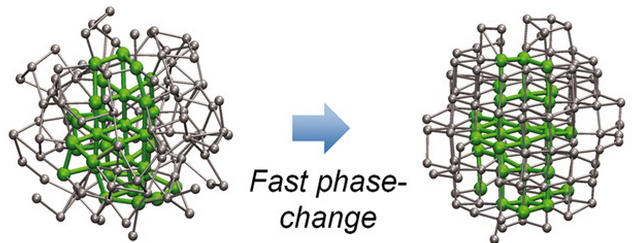Write speeds for phase-change memory reach record limits
June 28, 2012 | Source: Ars Technica

Fast phase-change (credit: D. Loke/Science)
By pre-organizing atoms in a bit of phase-change memory, information can be written in less than one nanosecond, the fastest for such memory.
With write speeds comparable to the memory that powers our computers, phase change memory could one day help computers boot up instantly.
Phase-change memory stores information based on the organization of atoms in a material, often a mixture of germanium, antimony, and tellurium (Ge2Sb2Te5 or GST). A voltage pulse heats the metal and disordered atoms in the crystal rearrange into an ordered crystal. Restoring the disordered arrangement by melting the glassy material erases the information. A computer reads each bit by detecting the lower electrical resistance of the ordered crystal.
Phase-change memory could one day replace flash memory in our cellphones, just as Samsung briefly tried in a commercial smartphone. PRAM can top the density and write times of flash memory. And like flash, PRAM is nonvolatile, meaning that it retains its information even when a device is powered off.
That makes phase-change memory an intriguing candidate to replace the volatile DRAM that powers our computers. But a computer that boots up instantly using PRAM is still a long way off, partly because the materials can’t be switched from disordered to ordered, or written quickly enough.
Most phase-change materials crystallize slower than the 1-10 nanoseconds it takes to write a bit of DRAM. And materials that crystallize faster at PRAM operating temperatures tend to naturally organize at lower temperatures too, says Stephen Elliott of the University of Cambridge. Therefore, they slowly crystallize and erase themselves over time.
Elliott and his colleagues have boosted the crystallization time, and thus the write speed, of a stable PRAM bit. They pre-organized the atoms in a chunk of Ge2Sb2Te5 using a weak electric field. The scientists sandwiched a 50nm-wide cylinder of GST between two titanium electrodes and applied 0.3V of potential across the material. A 500-picosecond burst of 1V electrical potential triggered the crystallization, which is about 10 times faster than the best speed using a germanium-tellurium material.